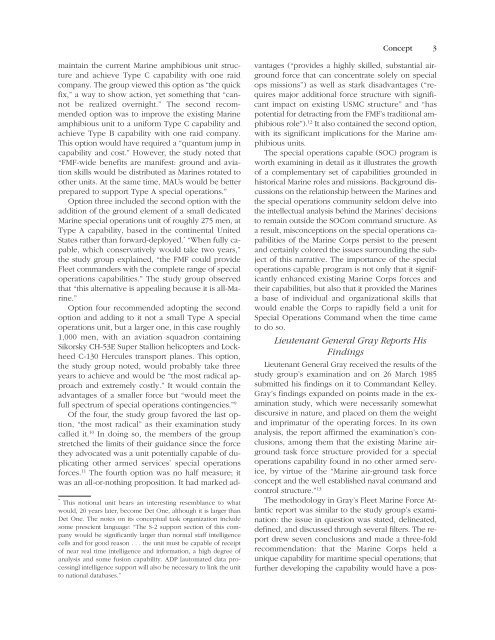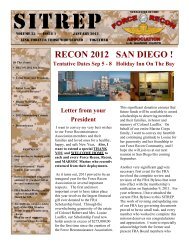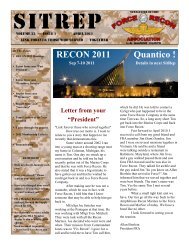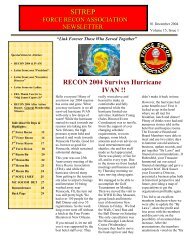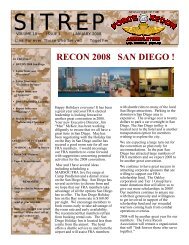Det One - Force Recon Association
Det One - Force Recon Association
Det One - Force Recon Association
You also want an ePaper? Increase the reach of your titles
YUMPU automatically turns print PDFs into web optimized ePapers that Google loves.
Concept 3<br />
* This notional unit bears an interesting resemblance to what<br />
would, 20 years later, become <strong>Det</strong> <strong>One</strong>, although it is larger than<br />
<strong>Det</strong> <strong>One</strong>. The notes on its conceptual task organization include<br />
some prescient language: “The S-2 support section of this company<br />
would be significantly larger than normal staff intelligence<br />
cells and for good reason . . . the unit must be capable of receipt<br />
of near real time intelligence and information, a high degree of<br />
analysis and some fusion capability. ADP [automated data processing]<br />
intelligence support will also be necessary to link the unit<br />
to national databases.”<br />
maintain the current Marine amphibious unit structure<br />
and achieve Type C capability with one raid<br />
company. The group viewed this option as “the quick<br />
fix,” a way to show action, yet something that “cannot<br />
be realized overnight.” The second recommended<br />
option was to improve the existing Marine<br />
amphibious unit to a uniform Type C capability and<br />
achieve Type B capability with one raid company.<br />
This option would have required a “quantum jump in<br />
capability and cost.” However, the study noted that<br />
“FMF-wide benefits are manifest: ground and aviation<br />
skills would be distributed as Marines rotated to<br />
other units. At the same time, MAUs would be better<br />
prepared to support Type A special operations.”<br />
Option three included the second option with the<br />
addition of the ground element of a small dedicated<br />
Marine special operations unit of roughly 275 men, at<br />
Type A capability, based in the continental United<br />
States rather than forward-deployed. * “When fully capable,<br />
which conservatively would take two years,”<br />
the study group explained, “the FMF could provide<br />
Fleet commanders with the complete range of special<br />
operations capabilities.” The study group observed<br />
that “this alternative is appealing because it is all-Marine.”<br />
Option four recommended adopting the second<br />
option and adding to it not a small Type A special<br />
operations unit, but a larger one, in this case roughly<br />
1,000 men, with an aviation squadron containing<br />
Sikorsky CH-53E Super Stallion helicopters and Lockheed<br />
C-130 Hercules transport planes. This option,<br />
the study group noted, would probably take three<br />
years to achieve and would be “the most radical approach<br />
and extremely costly.” It would contain the<br />
advantages of a smaller force but “would meet the<br />
full spectrum of special operations contingencies.” 9<br />
Of the four, the study group favored the last option,<br />
“the most radical” as their examination study<br />
called it. 10 In doing so, the members of the group<br />
stretched the limits of their guidance since the force<br />
they advocated was a unit potentially capable of duplicating<br />
other armed services’ special operations<br />
forces. 11 The fourth option was no half measure; it<br />
was an all-or-nothing proposition. It had marked advantages<br />
(“provides a highly skilled, substantial airground<br />
force that can concentrate solely on special<br />
ops missions”) as well as stark disadvantages (“requires<br />
major additional force structure with significant<br />
impact on existing USMC structure” and “has<br />
potential for detracting from the FMF’s traditional amphibious<br />
role”). 12 It also contained the second option,<br />
with its significant implications for the Marine amphibious<br />
units.<br />
The special operations capable (SOC) program is<br />
worth examining in detail as it illustrates the growth<br />
of a complementary set of capabilities grounded in<br />
historical Marine roles and missions. Background discussions<br />
on the relationship between the Marines and<br />
the special operations community seldom delve into<br />
the intellectual analysis behind the Marines’ decisions<br />
to remain outside the SOCom command structure. As<br />
a result, misconceptions on the special operations capabilities<br />
of the Marine Corps persist to the present<br />
and certainly colored the issues surrounding the subject<br />
of this narrative. The importance of the special<br />
operations capable program is not only that it significantly<br />
enhanced existing Marine Corps forces and<br />
their capabilities, but also that it provided the Marines<br />
a base of individual and organizational skills that<br />
would enable the Corps to rapidly field a unit for<br />
Special Operations Command when the time came<br />
to do so.<br />
Lieutenant General Gray Reports His<br />
Findings<br />
Lieutenant General Gray received the results of the<br />
study group’s examination and on 26 March 1985<br />
submitted his findings on it to Commandant Kelley.<br />
Gray’s findings expanded on points made in the examination<br />
study, which were necessarily somewhat<br />
discursive in nature, and placed on them the weight<br />
and imprimatur of the operating forces. In its own<br />
analysis, the report affirmed the examination’s conclusions,<br />
among them that the existing Marine airground<br />
task force structure provided for a special<br />
operations capability found in no other armed service,<br />
by virtue of the “Marine air-ground task force<br />
concept and the well established naval command and<br />
control structure.” 13<br />
The methodology in Gray’s Fleet Marine <strong>Force</strong> Atlantic<br />
report was similar to the study group’s examination:<br />
the issue in question was stated, delineated,<br />
defined, and discussed through several filters. The report<br />
drew seven conclusions and made a three-fold<br />
recommendation: that the Marine Corps held a<br />
unique capability for maritime special operations; that<br />
further developing the capability would have a pos-


